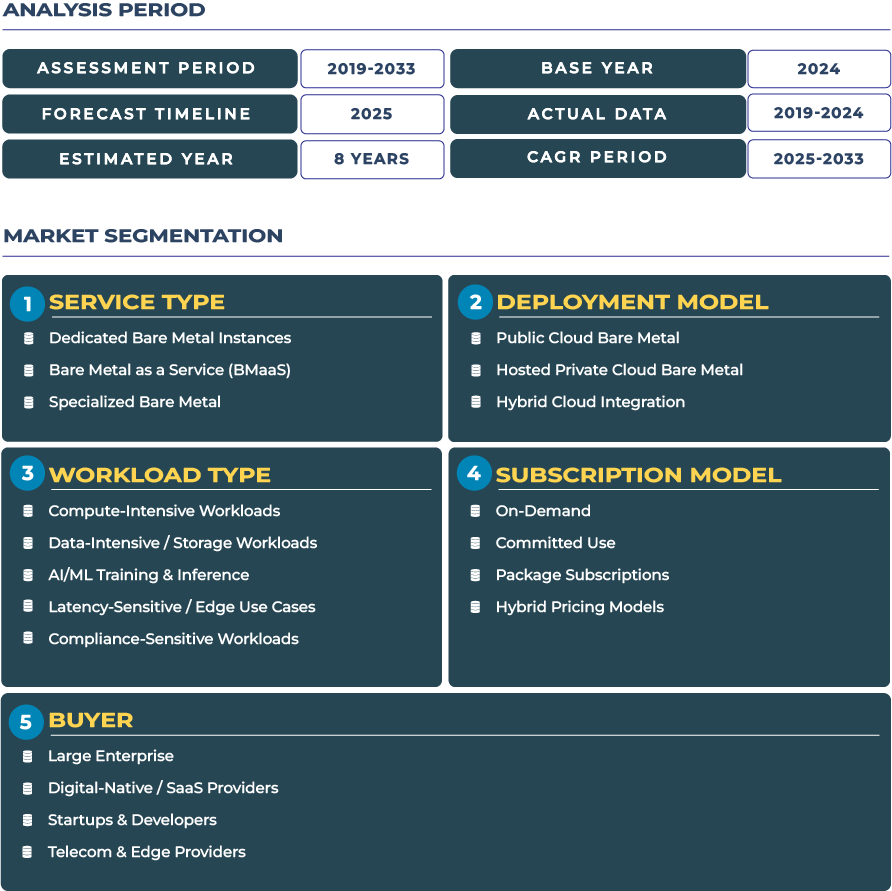Report Format:
![]()
![]() |
Pages: 110+
|
Pages: 110+
Zimbabwe Cloud Bare Metal Market Outlook: Research-Focused HPC and Pay-Per-Use Bare Metal Driving Emerging Compute Frontier
Zimbabwe is positioning itself as a promising market for HPC-ready, research-driven bare metal infrastructure. With emerging demand from universities, research labs, AI/ML initiatives, and fintech experimentation, the need for local high-performance compute that supports predictable throughput, accelerators, isolation, and pay-as-you-go usage is rising. Bare metal becomes the anchor compute layer that bridges the gap between limited virtual cloud offerings and expensive overseas deployments. In the Zimbabwe cloud bare metal ecosystem, strategic compute nodes-especially in Harare and Bulawayo-can serve as regional testbeds, disaster recovery corridors, and academic compute hubs.
The Zimbabwe cloud bare metal market is projected to scale from around USD 10.3 million in 2025 to approximately USD 55.8 million by 2033, implying a CAGR of about 23.6 %. This ambitious growth is justified by several structural shifts: increasing demand for research compute, nascent data center expansion, and strategic public and private investments. Currently, Zimbabwe hosts just three data centers-two in Harare and one in Bulawayo-according to data center listings. In recent developments, Dandemutande announced plans for a USD 15 million data center, expanding its portfolio in Harare, Bulawayo, and a site bridging the South Africa cross-border link. Simultaneously, a solar-powered data center initiative by Chillmine and Energywise, leveraging a 100 MW solar project, aims to reduce power cost barriers that inhibit data center expansion in Zimbabwe. The data center market briefing for Zimbabwe highlights constrained supply, grid challenges, regulatory inertia, and energy constraints as current structural limits-but also underscores growing investor interest in Tier 2/3 markets.
Drivers & Restraints: Forces Steering Zimbabwe Bare Metal Trajectory
Driver: Scientific Research & HPC Cluster Demand; Growth in AI / ML Model Training
One of the principal drivers is growing demand from Zimbabwe academic and research institutions for HPC clusters, AI/ML workloads, simulation, genomics, climate modeling, and engineering compute. The Zimbabwe Centre for High Performance Computing is already a leading local HPC resource. As research workloads scale, clusters deployed on bare metal deliver higher throughput, direct access to accelerators, and better optimization than shared virtualization layers. Moreover, as AI and ML models become more central to government, health, agriculture, and fintech initiatives, the compute envelope will demand hardware isolation, GPU/FPGA access, and lower latency than remote cloud instances can provide.
Restraint: Supply-Chain Constraints for GPUs & Geographic Data-Center Limitations
A major restraint is global supply constraints for GPUs, accelerators, and high-performance silicon, which limits how many specialized bare metal nodes can realistically be provisioned locally in Zimbabwe. These supply limitations also introduce cost premiums and delays. Another restraint is the limited geographic footprint of data centers in Zimbabwe-three listed colocation facilities-concentrated in Harare and Bulawayo-with no widespread regional deployment. This constrains latency zones and redundancy across regions. Additionally, grid reliability, power cost, cooling infrastructure, and capital intensity of bare metal deployments impose financial risk and deployment delays in Zimbabwe challenging infrastructure environment.
Trends & Opportunities: Emerging Patterns in Zimbabwe Bare Metal Market
Trend: Cloud-Native Workloads Migrating to Bare Metal for Efficiency
An observable trend is that cloud-native workloads-databases, AI inference nodes, analytics engines-are being migrated to bare metal to eliminate performance variability, noisy neighbor interference, and to enable direct hardware tuning. This migration is especially relevant in research, fintech, and blockchain pilots where throughput consistency and predictability matter. Another trend is a growing shift toward energy-aware bare metal design-such as pairing compute nodes with on-site renewable generation (e.g. solar) to mitigate Zimbabwe grid challenges. The Chillmine/Energywise solar data center initiative exemplifies this approach.
Opportunity: Pay-Per-Use HPC Testing Labs & Partnerships for Regional Colocation / Edge Nodes
A compelling opportunity lies in offering pay-as-you-use HPC testing labs for startups, research teams, and regional institutions who cannot afford full-time clusters. By providing on-demand bare metal cluster access, Zimbabwean infrastructure operators can democratize compute. Another opportunity is forging colocation partnerships and edge node deployment in secondary cities and border areas to serve East/Southern African cross-border needs. Facilities built near fiber links or international gateways can attract compute traffic from nearby countries lacking local infrastructure.
Competitive Landscape: Local Players & Strategic Moves
A central infrastructure player is TelOne, Zimbabwe state-owned telecommunications provider, offering data center, cloud services, rack space, and hosting via its backbone network. TelOne’s cloud and data center services portfolio gives it potential leverage to layer bare metal compute offerings upon existing infrastructure. On the commercial side, Dandemutande is planning multistate data center expansion and cloud infrastructure to bolster its footprint-potentially anchoring bare metal compute in Harare and Bulawayo. Meanwhile, Chillmine in partnership with Energywise is developing solar-powered data centers to offset power constraints and support compute growth.







